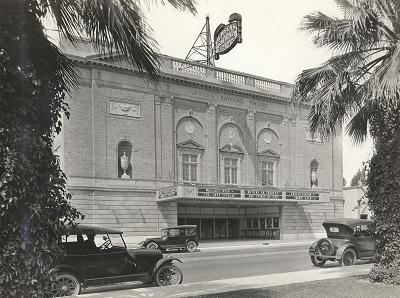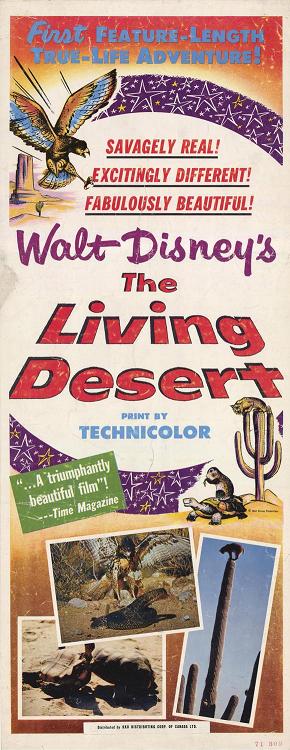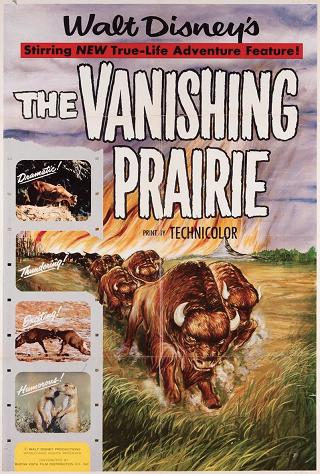February is Awards Season, and The Walt Disney Family Museum is celebrating, with film presentations and visitor programs throughout the month. Walt personally won 32 Academy Awards® throughout his career. To this day, Walt still holds the record for the most Oscars® won by an individual, and there is only one place where you can get an up-close look at more than 20 of the famous statuettes—The Walt Disney Family Museum. Screening this month in our museum’s state-of-the-art digital theatre is a collection of Walt’s award-winning True-Life Adventures films. Disney historian and writer Jim Fanning has contributed this excellent article about this pioneering film series, exclusively for Storyboard.
 When the Disneyland TV show first flashed across the nation’s television screens on October 27, 1954, the animated opening sequence promised that viewers would occasionally be welcomed into Adventureland, “the wonder world of nature’s own realm.” This came as no surprise to the audience watching that night, for by that momentous October evening, Walt Disney had already told many a story straight from nature’s wonder world in the form of his True-Life Adventure documentaries; he had also produced the first of his People and Places films, with another edition about to be released in December. The crowning glory of these innovative and beautifully photographed Disney documentaries was the great number of Academy Awards with which they were honored: eight of Walt’s thirteen True-Life Adventures shorts and features were Academy Award winners, while three of its lesser-known sister series, the People and Places films, were awarded golden statuettes.
When the Disneyland TV show first flashed across the nation’s television screens on October 27, 1954, the animated opening sequence promised that viewers would occasionally be welcomed into Adventureland, “the wonder world of nature’s own realm.” This came as no surprise to the audience watching that night, for by that momentous October evening, Walt Disney had already told many a story straight from nature’s wonder world in the form of his True-Life Adventure documentaries; he had also produced the first of his People and Places films, with another edition about to be released in December. The crowning glory of these innovative and beautifully photographed Disney documentaries was the great number of Academy Awards with which they were honored: eight of Walt’s thirteen True-Life Adventures shorts and features were Academy Award winners, while three of its lesser-known sister series, the People and Places films, were awarded golden statuettes.
Long renowned as the master of make-believe, Walt Disney effortlessly turned his genius as well as the skills of his Studio to the factual realm of nature when he first started the True-Life Adventures. Walt was a man “with an inquiring mind,” noted Disney writer-producer Winston Hibler, whose warm, calm and reasoned voice is immortalized in the narration of Disney’s award-winning documentaries. “There came a time when his great curiosity led him from the world of fantasy into the realm of fact. He produced a film called Seal Island, and since it was a true story he decided to call it a ‘True-Life Adventure.’ It won an Academy Award, and with that he was off into a whole new domain: the world of nature. For a span of ten years, he made a series of these nature films, long before the word ‘ecology’ had come into our common vocabulary.”
The Oscar-adorned True-Life Adventures began when Walt attended a travel lecture by Alfred and Elma Milotte in 1946. Fascinated with the Alaskan wildlife footage shot by this husband-and-wife team of nature photographers, he enlisted the Milottes to capture more of the unspoiled Alaskan wilderness on film. While others failed to find anything of much interest in the reels and reels of film the Milottes shipped back to the Studio, Walt saw the potential for spellbinding screen entertainment in their footage of fur seals spending the summer on the Pribilof Islands in the Bering Sea off the Alaskan coast. Using the principles he honed in creating his animated films — music, humor, drama, personality, audience identification—Walt crafted the Milottes’ film into 27 minutes of riveting animal adventure called Seal Island (1949). Disney’s distributor RKO had no interest in the novel film about seals on a rock, so Walt took the same approach he had taken withSteamboat Willie (1928) and the first Silly Symphony, The Skeleton Dance (1929); he persuaded a local theater, the Crown Theater in Pasadena, to exhibit Seal Island for a week in late December 1948. Walt’s knew that if Seal Island ran for one week in the Los Angeles, his new documentary would qualify for an Academy Award nomination. Walt knew he had a winner and the Academy agreed; on March 24, 1949, Walt accepted a Best Two-Reel Documentary Oscar for Seal Island from presenter Jeanne Crain at the Academy Awards ceremony in Hollywood. With that success, as well as the enthusiastic response of audiences, the True-Life Adventures were launched.
The Oscar gold garnered is a reminder of how revolutionary these documentary films were at the time of their release. There were some nature documentaries before Walt created the True-Life Adventures but none had the warmth, humor and engaging narrative skill of the Disney films; moreover, the True-Life Adventures featured wildlife footage that had never been seen before. For Beaver Valley (1950), the second installment released—and the second to win an Oscar—Walt instructed the Milottes (who lived at the beaver pond for seven months) to keep shooting until dark, even though most photographers conserved film by not shooting too late into the day, resulting in some remarkable footage. For the third True-Life Adventure, Nature’s Half Acre (1951), Walt enlisted fifteen cameramen, including cutting-edge time-lapse photography by John Ott Nash, resulting in yet another Oscar win.
 It wasn’t long before the great innovator expanded the True-Life Adventures into feature-length form. The Living Desert (1953) began when N. Paul Kenworthy, Jr. shared nature footage with Walt. This young photographer had studied insect life on the great American desert as part of a doctoral thesis for UCLA, and this spellbinding film—including a breathtaking sequence of a wasp battling a tarantula—was the result. As he had done with the Milottes and the seals, Walt engaged Paul to return to the desert for more film. In the end, Paul and other photographers filmed so much incredible wildlife in the seemingly barren desert that Walt decided to assemble the film into a feature. The Living Desert was an incredible box-office success, and its innovative artistry was acclaimed by the Academy with an Oscar for this first True-Life Adventure feature. The next feature, The Vanishing Prairie (1954) brought Walt another Oscar on March 30, 1955, from presenter Grace Kelly.
It wasn’t long before the great innovator expanded the True-Life Adventures into feature-length form. The Living Desert (1953) began when N. Paul Kenworthy, Jr. shared nature footage with Walt. This young photographer had studied insect life on the great American desert as part of a doctoral thesis for UCLA, and this spellbinding film—including a breathtaking sequence of a wasp battling a tarantula—was the result. As he had done with the Milottes and the seals, Walt engaged Paul to return to the desert for more film. In the end, Paul and other photographers filmed so much incredible wildlife in the seemingly barren desert that Walt decided to assemble the film into a feature. The Living Desert was an incredible box-office success, and its innovative artistry was acclaimed by the Academy with an Oscar for this first True-Life Adventure feature. The next feature, The Vanishing Prairie (1954) brought Walt another Oscar on March 30, 1955, from presenter Grace Kelly.
The Disney nature photographers — more than 40 as the series expanded into feature-length production — experienced many adventures of their own. Hugh Wilmar narrowly escaped an attacking polar bear while filming for Oscar-winnerWhite Wilderness (1958) in the Yukon; Tom McHugh shot close-ups of buffalo in Montana by donning a buffalo skin and mingling with the herd for the Academy Award-winning The Vanishing Prairie (1954); in unprecedented footage, Tom also filmed the birth of a bison calf. As a testament to the enduring power of these highly honored features, Disney re-released The Living Desert and The Vanishing Prairie as a double feature in 1971, proudly proclaiming the documentary-duo as “Two Great Academy Award Winners!”
“It was always Walt Disney’s belief,” said Winston Hibler, “that animals in themselves were interesting”— but Walt also believed that the great success of the True-Life Adventures could also be extended to another captivating subject: people. Walt knew the same storytelling principles he applied to theimo nature films could also be used to document the equally fascinating world of another “animal,” human beings—especially those who lived in exotic locales. “For People and Places,” Walt pledged, “our intention is to go into the hearts and mind and homes of our global neighbors, far and near. We shall show how they live today—how they work and play. The cameras will report them honestly but sympathetically…Many folk groups will be seen almost exactly as their forebears lived centuries ago.”
The People and Places films had the same Alaskan roots as the True-Life pictures, for Walt’s original request for the Milottes was to shoot anything of interest in Alaska, so in addition to filming wildlife, the photographers also captured Inuit life on film. Eventually Walt decided to focus on animals alone for his True-Life Adventures, so there was no place for the Milottes’ Inuit footage. The “lost” Alaskan footage was seen at last in The Alaskan Eskimo (1954), the first of the People and Places pictures. The freshly minted documentary presented the everyday home life of Inuit people in a typical village.
For the new People and Places film, Walt again won an Oscar right out of the gate, and on quite a monumental night, as it turned out. Walt’s wife Lillian was looking forward to attending the Academy Award ceremony on March 25, 1954. Walt, however, dismissed his chances of winning any awards that night, and convinced Lilly to stay home. Walt attended the Awards with Studio publicity head Tom Jones only to be presented with four Oscars. The winning films were Bear Country; the cartoon short Toot, Whistle, Plunk and Boom (presented by Keefe Brasselle and Marilyn Erskine, the stars of The Eddie Cantor Story); The Living Desert and, yes, The Alaskan Eskimo (presented by Elizabeth Taylor and her then-husband, British actor Michael Wilding). “Just gotta say one more word. It’s wonderful,” Walt commented as he won his fourth Oscar of the night, “but,” he added in a quick quip, “I think it’s my year to retire!” When Walt returned home with his armload of Oscars, Lilly was none too happy about having missed the big night.
 The Disney cameras spanned the globe to create other installments in this compelling series, covering such subjects as Siam (1954), The Blue Men of Morocco(1957) and, depicting one of Walt’s favorite subjects, Switzerland (1955), the first People and Places documentary to be filmed in the widescreen splendor of CinemaScope. Herbert and Trudie Knapp, the husband-wife team of photographers filmed many of the People and Places documentaries for Walt, including the Oscar-nominated Siam (1954).
The Disney cameras spanned the globe to create other installments in this compelling series, covering such subjects as Siam (1954), The Blue Men of Morocco(1957) and, depicting one of Walt’s favorite subjects, Switzerland (1955), the first People and Places documentary to be filmed in the widescreen splendor of CinemaScope. Herbert and Trudie Knapp, the husband-wife team of photographers filmed many of the People and Places documentaries for Walt, including the Oscar-nominated Siam (1954).
Aside from The Alaskan Eskimo, the other People and Places documentaries to be awarded Oscars were Men Against the Arctic (1955) and Ama Girls (1958), both in CinemaScope. Men Against the Arctic centered on the dedicated Coast Guard sailors manning an “icebreaker”—a specially constructed ship designed to travel through the Arctic ice packs— attempting to reach Greenland. Filmed in Japan,Ama Girls documented young female divers whose livelihood comes from the harvesting of a seaweed known as “Heaven Grass.” As Walt intended, the People and Places series are not typical travelogues but instead capture unique ways of life. “In our film visits to faraway lands, we have found that every people has a wealth of ancient lore—every place a treasure of rich tradition. Each land is steeped in the memory of historic times that shaped the lives of its people. Our People and Places pictures are living records of some of the unique customs and old cultures that still endure in remote and isolated corners of the globe.”
The Oscars awarded to both documentary series went a long way to making Walt Disney the all-time record holder for most Academy Awards wins—Walt received 32 of Hollywood’s most prestigious awards from the Academy of Motion Pictures Arts and Sciences. As honored and pleased as Walt undoubtedly was at his documentaries receiving these accolades, these films to which the filmmaker was so dedicated held a deeper meaning. As for the People and Places films, Walt stated his hope that “through our pictures…a contribution may be made toward strengthening the bonds of good will and understanding by which all men can exist together in peace.”
Whether it be adventurous animals in their true-life habitats or people in their fascinating places, Walt Disney’s Academy Award-winning documentaries continue to entertain, educate and enthrall—and the shelf-full of Oscars awarded to them shine as a testament to Walt’s unforgettable filmmaking.
Jim Fanning is a writer, historian, editor and researcher specializing in Disney. In a career dedicated to celebrating and exploring the work and life of Walt Disney, Jim has authored books, magazine articles, TV documentaries, comics and a variety of other works, including a biography of Walt Disney. A contributor to Disney twenty-three Magazine and the D23 website, Jim has written officially-commissioned projects for many departments of The Walt Disney Company, and has interviewed many Disney Legends, including Frank Thomas, Ollie Johnston, Marc Davis, Carl Barks, and the Sherman Brothers. He also wrote many episodes of the groundbreaking documentary TV series,Disney Family Album, and has contributed writing and research to The Walt Disney Family Museum.
Film programs through February change weekly, with screenings daily at 1:00pm and 4:00pm (except Tuesdays, and February 18, 25 and 26). Further program information and tickets are available at the Reception and Member Service Desk at the Museum, or online by clicking here.
On Saturday February 18, the special program And the Award Goes to...Walt Disney offers a one-of-a-kind showcase of Walt Disney’s Award Winners. Hosted by author, Disney historian and friend of the Museum Jeff Kurtti, this program offers a look at highlights of Walt Disney’s Oscar-winning films, including rarities such as Parade of the Award Nominees (1932), Ferdinand the Bull (1938), and Grand Canyon (1958); as well as trailers and rare footage and photos of Walt at the Oscar Ceremonies. (Separate admission required.)
On Saturday February 25 at 2:00pm, the special program Walt Disney’s Worlds of Nature will feature Academy Award-nominated producer Don Hahn (Beauty and the Beast, The Little Matchgirl) and a presentation about Walt’s pioneering and frequently-emulated True-Life Adventures films, and showing the relationship between that series and the acclaimed Disneynature documentaries (Earth, Oceans,African Cats, and the upcoming Chimpanzees) for which Hahn serves as executive producer. (Separate admission required.)
The Oscar statuette is the copyrighted property of the Academy of Motion Picture Arts and Sciences, and the statuette and the phrases "Academy Award(s)" and "Oscar(s)" are registered trademarks.
Images: 1) The Raymond Theatre had just changed its name to the Crown in 1948 when Seal Island premiered there. 2 & 3) © Disney.
